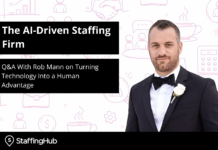
The pandemic rendered the standard playbooks for how we do nearly everything — from grocery shopping to schooling — obsolete. But perhaps no area of our lives has changed more than how we work. For their 2021 Talent Trends Report, Randstad Sourceright interviewed 850 human capital and C-suite leaders worldwide to identify the top talent trends for this year.
Here’s a brief overview of what talent trends Randstad Sourceright predicts will determine companies’ success. The full report offers more data and insight into how to adopt these trends into your talent strategies.
Prioritizing skills
The pandemic has squeezed budgets. At the same time, the skills gap has not gone away. This has caused companies to rethink their hiring practices as well as how to use their current talent more strategically.
Trends
Skills, not jobs
In the survey, 77% of human capital leaders said their talent strategies are more focused on agility than ever before. This often takes the form of a total talent management approach, which relies more heavily on contingent talent. Randstad Sourceright describes the new flexible, value-based strategy as “how work gets done, instead of how jobs are filled.”
Talent development
40% of survey respondents said “talent scarcity has either made a negative impact or been one of their organization’s biggest pain points.” Digital skills, including artificial intelligence (AI) and analytics, are among the top areas of concern. In addition to building their talent pipelines, companies are launching programs to help their current talent develop key new skills — 20% of respondents said they’ve provided training in the past 12 months aimed at addressing changing business needs.
Reskilling
Technological advances cause some jobs to be eliminated, some jobs to change, and some new types of jobs to emerge. To keep up with the changes, companies will need to upskill and reskill their workforce. 92% of survey respondents said they believe it’s up to companies to reskill workers, and 87% said that reskilling will help with retention.
Offering flexibility
The pandemic has proved that many of the old ways of doing things weren’t necessarily good — they were just comfortable. Going forward, companies will need to offer more flexible working arrangements to attract and retain top talent.
Trends
Flexible work arrangements
With so many industries moving to a work-from-home (WFH) model, flexible work arrangements are now the norm. This will likely continue post-pandemic. Eight in ten respondents to the Randstad Sourceright survey said their business will consider some kind of permanent WFH policy. Other options include hybrid work schedules and increased support for working parents and caregivers.
Borderless talent
Many companies that previously placed geographical limits on where employees could live are now loosening those restrictions and bringing on permanently remote employees. This will be to their advantage, according to the report: “as organizations become more effective at remote recruitment and meeting talent expectations, borderless talent acquisition can help deliver the agile and responsive workforce that’s needed in today’s uncertain environment.”
Leveraging technology
As our work lives move increasingly online, technology adoption is becoming increasingly important to the talent experience. Randstad found that 47% of leaders are already investing in technology to improve the talent experience at work.
Trends
Digital transformation
With the transition to WFH (and the resultant lack of a daily commute), many companies reported that productivity actually improved last year. To sustain the elevated level of productivity, Randstad Sourceright suggests companies will need to accelerate their digital transformation — 73% of leaders said they expect innovation will help their talent teams focus on business-critical activities.
Data-driven decision-making
You can’t make good decisions without data. According to the report, talent analytics is the top technology human capital leaders are investing in to gain better insight into their talent operations so they can make better workforce decisions.
Putting people first
When people look for jobs today, they’re looking for more than a good salary and traditional benefits. Job seekers want to know that they’ll be treated as a person, not just a worker bee, and that the company’s values align with their own.
Trends
Health and wellness
Randstad Sourceright notes that “health and wellness challenges emerged as one of the most pressing workforce issues…in 2020.” In the survey, 62% of HR leaders say a wellness program is extremely or very important to attracting talent.
Diversity and inclusion
The events of last year brought diversity and inclusion to the forefront, with employees (and consumers) demanding that the companies they support take meaningful steps toward change. Randstad Sourceright’s survey found that 80% of leaders believe it’s important to have a robust diversity and inclusion strategy.
Employer branding
Nearly two-thirds (63%) of respondents said the talent experience is more important now than it was before the pandemic. Many of the previous trends on this list will help you boost your employer brand.





